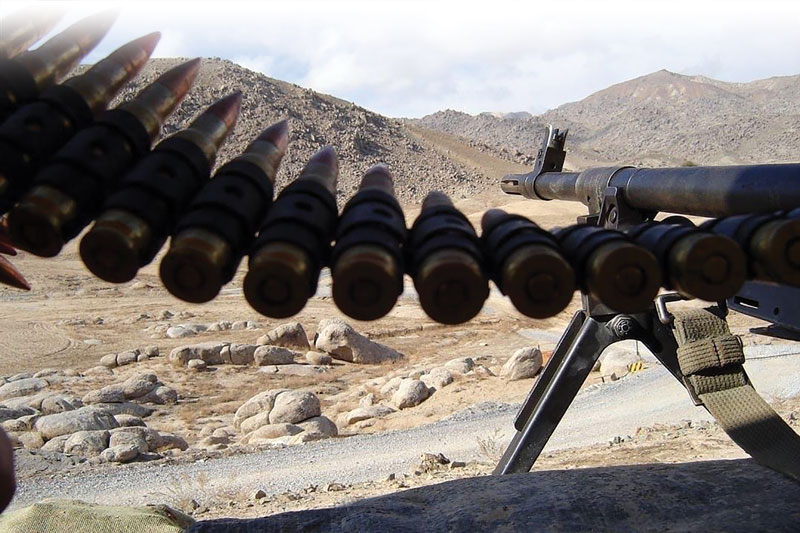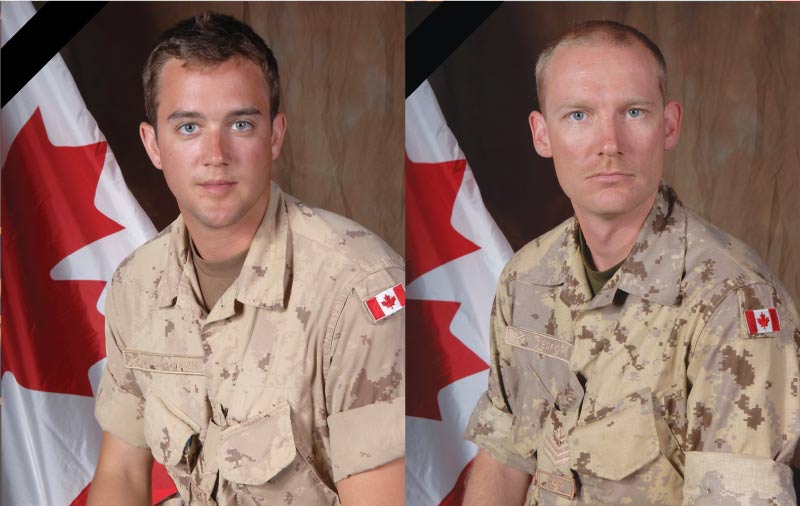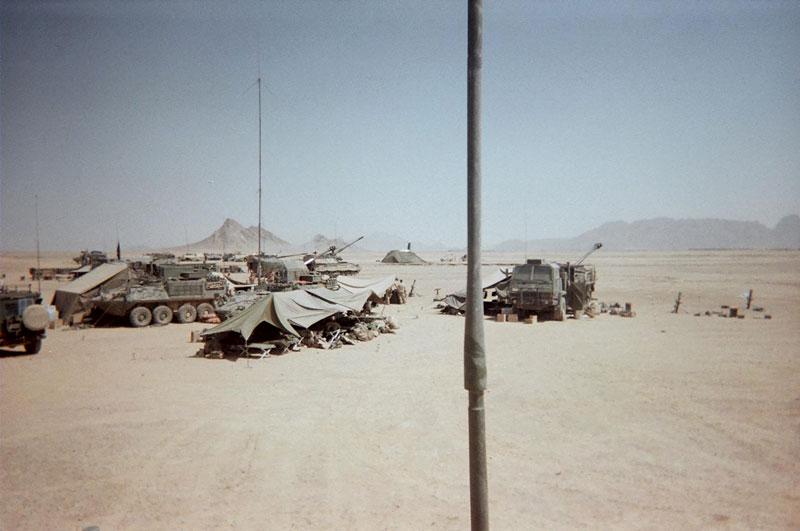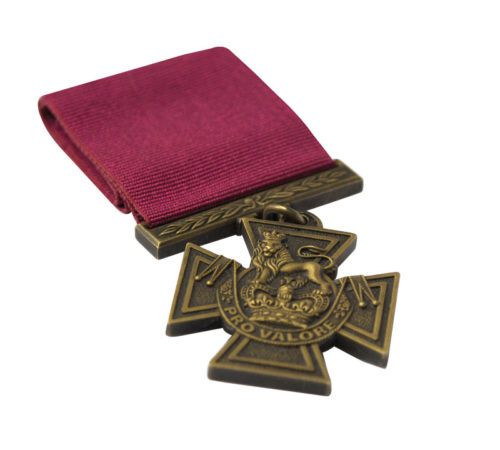
The C6 machine gun is known as a “bullet magnet” because neutralizing it is one of the enemy’s primary objectives.[Bruce Moncur]

Private Jess Randall Larochelle and the rest of 9 Platoon, Charles Company, 1st Battalion, Royal Canadian Regiment, had just arrived at a remote strongpoint in southern Afghanistan when all hell broke loose.
A Taliban force attacked their position. Two RCR soldiers were killed and several wounded, including Larochelle. The events of Oct. 14, 2006, forever altered the lives of the 24-year-old private and those who fought with him.
In addition to soldierly excellence, Larochelle displayed “moral courage, an overwhelming sense of duty” to his fellow troops, said retired lieutenant-general Omer Lavoie, the battle group commander who was in the firefight that day.
The attackers came so close that when Lavoie, then a lieutenant-colonel, summoned an artillery strike, he called “danger close,” meaning the gap between the enemy and his force was so small there was a risk that friendly fire would come down on his own troops. It was, in fact, so close that coalition shrapnel embedded itself in Lavoie’s vehicle.
Larochelle’s unit was undermanned before the fighting even started. One of its four light-armoured vehicles, known as LAV IIIs, had run over an improvised explosive device shortly after they left Patrol Base Wilson, some 30 kilometres west of Kandahar in southern Afghanistan’s Zhari district.
Two men suffered concussions, one of their LAV’s eight wheels was blown off, and the not-so-light 17-tonne vehicle turned back. The rest pushed on to Strong Point Centre near Pashmul, the middle position in the battle group’s defences. They were to provide security for new road construction in a zone known as Ambush Alley.
“The only existing route through the area was a narrow dirt road that snaked its way through closely directed and restricted (canalizing) terrain that cut through built-up areas and a complex array of compounds,” wrote retired colonel Bernd Horn, an army historian. “As such, it was impossible to secure and a nightmare to traverse. Most armoured vehicles were simply too large to transit it. Moreover, IEDs and ambushes were a constant threat in an environment that favoured attackers.”

Privates Jess Larochelle and Blake Williamson in quieter times. Williamson was killed by an RPG strike at the outset of the Taliban attack. [Courtesy Jeremy Leblanc]
The new road was to cut straight through marijuana fields and vineyards. It was supposed to ease the military’s job of observation, control and security—and provide local farmers with an efficient route from the fertile Arghandab River valley to the major artery leading into the markets of Kandahar.
But first, the Canadians would have to bring some semblance of security to the area. Just how difficult that job would be quickly became evident to the members of 9 Platoon for they had no sooner arrived at the strongpoint when a warning came over the radio that they were about to be attacked.

LAV IIIs of 9 Platoon, 1st Battalion, RCR, manoeuvre minutes before the fighting broke out at Strong Point Centre.[DND; Cpl. Lou Penney]
The battle group was no stranger to combat. Or casualties. Having just come off Operation Medusa, the soldiers of 1RCR were also accustomed to fighting shorthanded.
Assigned to a rambling area of operations of about 60,000 square kilometres, they were stretched thin—a circumstance exacerbated by the fact that 15 task force soldiers had already been killed in action and another 85 wounded.
Lavoie was on a “battlefield circulation” and was just about to move on to his next stop when the call came in. His tactical headquarters—three LAVs and a Nyala mine-resistant vehicle, took up fighting positions. Larochelle’s platoon mates mounted up and prepared for what, for some, would be the fight of their lives—a frontal attack by a determined enemy.
To the fore stretched 100 metres of sand. Beyond that were marijuana fields, vineyards and scattered mud compounds and grape-drying huts.

Williamson (left) and Sergeant Darcy Tedford were in a light-armoured vehicle when an RPG exploded directly above the turret, killing the two men.[Combat Camera/DND].
“Fields of view were limited,” wrote Horn. “Sheltered behind the large mud building that was the centre point of the defensive position, protected by a natural wall to its other side, [a] LAV III aimed its deadly cannon to the north, providing cover to the road approach.
“Dug into this raised island that constituted Strong Point Centre, were two machine-gun pits. One faced south to control the road, while the other faced east to cover the close terrain, mainly grape vineyards, which extended right up to the defensive position. The platoon had also augmented the natural fortress with a series of sandbagged walls to provide additional protection and fighting positions.”
The unit needed someone to man the south-facing machine gun, located in an elevated observation post (OP) on the perimeter. The OP was about three metres square, reinforced by sandbags with a corrugated steel plate for a roof.
Given the platoon’s reduced numbers, whoever took the job of defending it would be alone and the most exposed Canadian in the group. It was not a job the second-in-command wanted to order anyone to do. He asked who was willing. Larochelle volunteered.
“They fired two rockets simultaneously.”
Originally from Sioux Lookout, Ont., Larochelle had been in-country for two months. He’d taken fire from the enemy but rarely had he gotten a good look at them. Soon, they’d be almost in his face.
He’d been raised in a military family. Both his parents were army veterans. The well-travelled Larochelle grew up fostering a love for the outdoors, camping and fishing, and refining his carpentry skills.
As a soldier, he was a machine-gun specialist. The C6 was his baby. He had a pack filled with 600 of the weapon’s belted 7.62mm rounds; two of the guns were already in the observation post, each loaded with 200 more.
Normally, the C6 is manned by two soldiers—one does the firing and the other feeds the ammunition. The weapon is so effective it is known as a “bullet magnet” because it attracts so much unwanted attention from the enemy.
Larochelle also brought along his light machine gun for good measure. He figured it was sometime after 2:30 p.m.
“I wasn’t in the observation post very long and we were fired upon—ambushed—by the Taliban,” he told retired general Rick Hillier in a recorded talk for the advocacy group, Valour in the Presence of the Enemy, obtained by Legion Magazine. “They fired two rockets simultaneously.”
One of the rocket-propelled grenades (RPGs) hit the antenna on the 2 Section LAV adjacent to his OP—Larochelle’s vehicle. It was a freak shot that detonated the rocket directly over the turret and killed two soldiers: Sergeant Darcy Tedford, a Calgary native raised in rural Nova Scotia, and Kemptville, Ont.-born Pte. Blake Williamson, one of Larochelle’s closest buddies. Several others were wounded.

Soldiers of the 1RCR Battle Group pick their way through smoky ruins. [Jeremy Leblanc]
The other RPG hit Larochelle’s position and hurled him in a storm of dirt and debris several metres across the observation post, smashing him into the wall behind him. He estimates he lost consciousness for about eight seconds—“just long enough to realize, ‘crap, I’ve just been knocked out.’”
The concussive blast and the impact had broken his back, fractured two vertebrae in his neck, blown his right eardrum and detached his right retina. His spinal cord was intact, but he was peppered with shrapnel. Bloodied, sorting out the flood of pain and reeling from the concussion, his training—and adrenaline—kicked in.
Their position was about to be overrun by as many as 40 Taliban. Larochelle had little time and no choice but to fight.
One of the C6s had been destroyed by the blast. Larochelle crawled back to the other weapon and began firing.
“The enemy attack washed over him like a rogue wave,” wrote Horn. “His position erupted in explosions as bullets and shrapnel hissed through the air around him.
“Larochelle thought he was hallucinating when he witnessed what he perceived as mini-explosions going off above his outpost.”
Some of the enemy were using 75mm RPG munitions packed with cluster rounds. When they detonated, they showered the area with deadly shrapnel.
“Despite the weight of fire directed upon him, Larochelle continued to fire back,” noted Horn.
He didn’t do so blindly, crouching and raising the gun over the wall as the insurgents often did. He was exposed for much of the fight, aiming, ensuring he got the most he could from each bullet as he shot in bursts of three to five rounds.
“Three to five rounds is most effective,” Larochelle said. “And if you try any more than that, your knuckles are chattering and your gun is bouncing around and you’re not really hitting anything that you’re aiming at any more.”
Red tracers made their deadly, lazy arcs every fourth round, giving him a reference of fire. The downside of tracers is that they also offer the enemy a precise aiming point. Taliban bullets were snapping over his head and all around him. He could see the nearest enemy fighters less than 200 metres away.
His gun barrel was smoking; hundreds of hot casings were bouncing off his hands and body and piling up around him as he fired.

LAV IIIs and other 1RCR vehicles at Patrol Base Wilson, west of Kandahar. [Bruce Moncur]
“I was crawling in them,” he said. “I eventually had to put gloves on and scoop the rounds out of my trench when I could get a chance because they were too hot—they were burning my hands and knees.
“After shooting that many rounds, it’s not very fun anymore.”
As the battle progressed, the smoke and dust started to obscure his view. Horn said Larochelle fired “at any movement or weapon signature he could see.”
He “maintained his combat discipline and continued to observe his arcs of fire in order to ensure no enemy was approaching from the east, even though he was taking heavy fire from the west.”
His 2 Section LAV was not firing at all, its turret motionless. He suspected the worst. His ammo was running low. Off to one side was a cache of 15 M72 rocket launchers, scattered by the blast that had knocked him out.
The single-shot weapon is more compact than a bazooka. It consists of a disposable green tube with a trigger, two sights on top and a shoulder mount below. It comes loaded.
There are instructions printed on the side of the extendable tube, but if you must read those in a predicament like Larochelle’s, you’re in real trouble.
Larochelle knew the drill: remove the rubber caps from each end, extend the tube, disengage the safety just in front of the rear sight—and you’re ready to fire. Brace the rubber mount on your shoulder and press the trigger, usually a rubber-encased button.
The shooter must be prepared, because the M72 has a kick. Larochelle described the weapon as “very accurate, if you’re using the sight properly.” Good to about 200 metres, “it makes quite an explosion.”
Trouble was, Larochelle had no idea if the M72s at hand had been damaged by the Taliban rocket blast. Had any been bent or otherwise compromised, he could be killed just firing them.
Ignoring the risk, he started pulling off the rubber stoppers, extending the disposable tubes and taking aim at the nearest enemy.
The weapon was devastatingly effective. Taliban fighters were blown to pieces with each shot, body parts flying in all directions.
Taliban bullets were snapping over his head and all around him.
The main gun aboard at least one of the remaining LAVs went down twice during the fighting. Another jammed once. Larochelle and his cache of M72s became even more critical to their defence as crews tried to clear their weapons.
Lavoie, meanwhile, had called a counterattack. As his LAV jockeyed into a firing position, it got hung up on a furrow in a grape field. The front end was pointing up and his gunner could not lower the cannon enough to fire effectively. The vehicle’s vulnerable underbelly was exposed to the enemy.
Lavoie crawled out of the turret and manned a machine gun on the crew commander’s side. He fired 2,000-3,000 rounds “just to keep the Taliban from firing an RPG through the belly of our vehicle.” Another LAV pulled them out.
Enemy RPGs and mortar rounds were coming in, bracketing the Canadian position and coming especially close to Larochelle’s disabled LAV. Larochelle could see a mortar pit out in front of him. He fired a rocket and took it out, then continued firing M72s until his cache was almost gone.
The surviving enemy fighters didn’t quit. Another RPG hit the wall below the sandbags fortifying Larochelle’s position, spraying dust and dirt in his face.
It did no damage of consequence and, apparently unnerved by the devastation wrought by the M72s and the LAVs’ 25mm chain guns, what was left of the Taliban force began a scattered retreat. Larochelle took up the C6 again and peppered them with 7.62mm fire.
The action had lasted about an hour. Lavoie ordered his tactical headquarters to evacuate the casualties and resupply the platoon with ammunition.
Larochelle was down to two M72s and the last 100 of his 800 heavy machine-gun rounds. He knew that because he had counted them off.
“As the battle’s going on, you have to count everything,” he said. “You count how many enemies been killed, how many are alive, where they are, how much ammo you have left, how much water you’ve got.
“You’ve got to be thinking about all of that stuff all of the time. There’s a lot more to it than just shooting back and forth at each other.”
Assuming the Taliban were regrouping, he steeled himself for another attack.
His platoon commander, then-lieutenant Raymond Corby, made his way out to the OP, calling out for confirmation that Larochelle was ok. He said he was.
Corby surveyed the scene.
“Did you fire all these rocket launchers?” he asked. They were scattered everywhere.
“Yes,” replied Larochelle.
“Cover me, I’m coming in,” said Corby, and Larochelle fired off some rounds.
The private briefed his commander on enemy numbers, locations and whatever other intelligence he could muster. He then provided cover fire while the lieutenant made his way the short distance to the disabled 2 Section LAV.
Corby, reported Horn, was “humbled by the young soldier’s valiant efforts.”
News filtered out that the unit had two “VSA,” or vital signs absent. Larochelle knew they had to be in his LAV, which had taken a second round in the battle.
There was still periodic fire. Troops administered first aid to the wounded. All but two in Larochelle’s 10-man section had taken shrapnel, he said. “Everybody had some sort of wound.”
A corporal brought Larochelle a box of ammo and water. His CamelBak water pack had been sucked dry.
“The platoon warrant officer came out and asked me if I wanted to be replaced and I said, ‘no, I’ll stay. I don’t think you want to put somebody through that who hasn’t been through it before. I can handle it if it happens again.’”
So they left him there, and sent him a partner, Corporal Darryl Jones. It was Jones who confirmed that Tedford and Williamson were dead.
The firing gradually subsided. It got quiet. Some units withdrew to Patrol Base Wilson. Larochelle, Jones and Warrant Officer Scott Robertson spent a sleepless night in the OP with only water to sustain them.
In a series of co-ordinated attacks, the Taliban had hit five different locations throughout the operations area on that Saturday.
There were no further attacks on Strong Point Centre, but Larochelle was now feeling intense pain and his equilibrium was shot. He was stumbling around the OP “like a drunk.”
“I was in a lot of pain,” he said. “My neck and back were really hurting and I was bleeding from my right ear. I was having problems with my vision in my right eye. My retina was detached, I found out.”
The rest of the platoon was relieved the next day and headed back to Kandahar airfield, the region’s main coalition military base, stopping at Wilson on the way and arriving at their destination after nightfall. They held the ramp ceremony for Tedford and Williamson almost immediately.
Platoon members carried the flag-draped coffins. Despite his undiagnosed pain, Larochelle helped carry his buddy Williamson’s coffin.
Afterward, Larochelle went straight to a base hospital where, two days after the battle, a doctor informed him that he had broken vertebrae in his back and fractured vertebrae in his neck. He was going home.
The repatriation process, however, was excruciating. He had trouble finding a flight out. He was put in a bed and told to wait. After a week of inaction, he started complaining. “I was almost being treated like I was a burden for being injured.”
He eventually caught a flight to Dubai, where he languished until, finally, he got two civilian flights home, via London.
He was hospitalized on arrival in Ottawa. There, doctors discovered internal bleeding, torn muscles and other damage. They did what they could, then sent him home to Garrison Petawawa.
“I thought that this was about as close to a VC as you’re going to get.”
Larochelle was awarded the Star of Military Valour, the forces’ second-highest decoration.
“Although he was alone, severely injured, and under sustained enemy fire in his exposed position at the ruined observation post, he aggressively provided covering fire over the otherwise undefended flank of
his company’s position,” said his citation. “Private Larochelle’s heroic actions permitted the remainder of the company to defend their battle positions and to successfully fend off the sustained attack of more than 20 insurgents.
“His valiant conduct saved the lives of many members of his company.”
It had been Lavoie’s job to nominate him for a decoration. Other than to designate “for valour,” which limited Larochelle to one of three possible awards, he could not recommend which one he thought his unassuming private should receive.
But for his own satisfaction, the general compared Larochelle’s actions to those of several historical Victoria Cross recipients. He told Legion Magazine he had no doubt at the time that his private’s citation “met all of the potential ingredients.”
“When I signed off on that citation, I thought that this was about as close to a VC as you’re going to get.”
Larochelle’s wounds were so severe, military doctors prohibited him from doing his job. They were still pulling shrapnel from his body two years after the fight. He was designated for back surgery, but never got it.
Larochelle felt he had no option but to leave the army. Unable to attend the ceremony at Rideau Hall, he received his award the same day he was released. It was 2008.
Now 39 and living with his parents near North Bay, Ont., wracked by pain and post-traumatic stress disorder, still deaf in his right ear, he has struggled mightily.
“I have,” he said, “no regrets.”
The case of Victoria Cross

Victoria Cross Medal [Corporal Issa Paré, Rideau Hall © OSGG-BSGG, 2007]
At publication time, momentum was growing in a public campaign to formally nominate Jess Larochelle as the first recipient of Canada’s Victoria Cross.
The advocacy group, Valour in the Presence of the Enemy, spearheaded by a former comrade in arms, Bruce Moncur, had been calling for a review of Larochelle’s file to get his Star of Military Valour upgraded to a VC.
In less than 24 hours, a group-sponsored petition garnered the 500 signatures needed to be tabled and presented to the House of Commons. Its signatories soon exceeded 12,000. It was open for signature until March 2.
A spokesperson for the chief of the defence staff, General Wayne Eyre, confirmed the country’s top soldier was consulting with Commonwealth allies and reviewing Larochelle’s file. The Royal Canadian Legion endorsed the effort.
Ninety-eight Canadians are among 1,358 British Empire and Commonwealth soldiers, sailors and aircrew to have earned the original Victoria Cross, the last of them Lieutenant Robert Hampton Gray in 1945.
In 1993, Canada followed Australia’s precedent and established its own VC. New Zealand did so in 1999. But while Australia has awarded four of the new VCs and New Zealand one, Canada has awarded none.
There were 109 actions honoured with intermediate gallantry awards in Afghanistan, including 20 Stars of Military Valour (SMV), said Lieutenant-Colonel Carl Gauthier, the military’s director of honours and recognition, in 2018.
A committee of general officers representing all commands reviewed all the citations and nomination processes, concluding they were fair and consistent throughout. They even compared them with Commonwealth VCs dating to Vietnam.
The awards process is complex. Any witness can nominate a VC candidate, but it must be endorsed by the nominee’s unit commander and is subject to reviews and revisions before it reaches the honours and recognition panel for a decision.
“I personally witnessed the valour of Jess Larochelle as he continued to fight while wounded and in the midst of his wounded and dead comrades,” said retired lieutenant-general Omer Lavoie, who commanded Larochelle’s 1RCR Battle Group.
“I have always felt that his actions that day in continuing to fight despite being wounded in order to break the enemy attack was worthy and commensurate with the historical awarding of a Victoria Cross.”
Advertisement





















